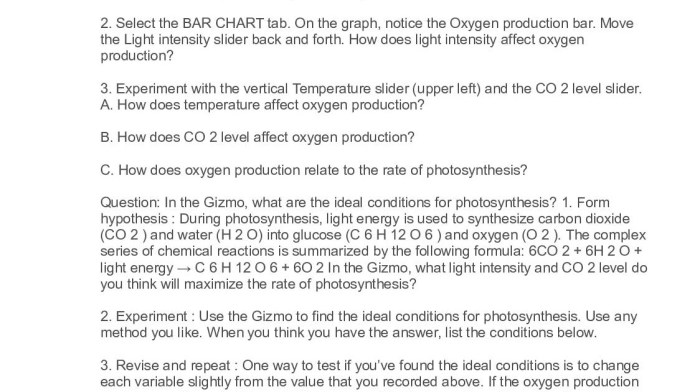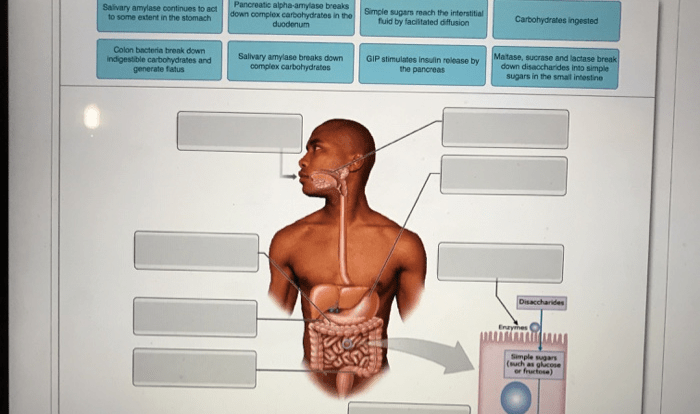Unveiling the intricacies of plant life, the Gizmo Photosynthesis Lab Answer Key empowers students and educators alike to delve into the fascinating world of photosynthesis. Through engaging simulations and comprehensive data analysis, this lab unravels the fundamental processes that sustain our planet’s ecosystems.
This interactive learning experience allows users to manipulate variables, observe real-time results, and gain a deeper understanding of the light-dependent and light-independent reactions that drive plant growth and oxygen production.
Gizmo Photosynthesis Lab Overview

The Gizmo Photosynthesis Lab is a virtual simulation that allows students to explore the process of photosynthesis. Students can manipulate variables such as light intensity, carbon dioxide concentration, and temperature to see how they affect the rate of photosynthesis.
The lab consists of the following steps:
- Set up the experiment by selecting the variables to be manipulated.
- Run the experiment and collect data on the rate of photosynthesis.
- Analyze the data to determine the effects of the manipulated variables on the rate of photosynthesis.
Variables in the Lab
The following variables can be manipulated in the Gizmo Photosynthesis Lab:
- Light intensity
- Carbon dioxide concentration
- Temperature
Steps Involved in Conducting the Lab
The following steps are involved in conducting the Gizmo Photosynthesis Lab:
- Set up the experiment by selecting the variables to be manipulated.
- Run the experiment and collect data on the rate of photosynthesis.
- Analyze the data to determine the effects of the manipulated variables on the rate of photosynthesis.
Photosynthesis Background Information
Photosynthesis is a crucial process in which plants, algae, and certain bacteria convert light energy into chemical energy, producing oxygen and organic compounds. It serves as the primary source of food and energy for nearly all life on Earth.
Role of Chlorophyll
Chlorophyll is a green pigment found in chloroplasts, the organelles responsible for photosynthesis. It absorbs light energy, primarily in the blue and red wavelengths, and transfers it to reaction centers within the chloroplast.
Light-Dependent Reactions, Gizmo photosynthesis lab answer key
The light-dependent reactions occur in the thylakoid membranes of chloroplasts. They utilize light energy to generate ATP and NADPH, the energy carriers for the light-independent reactions.
Light-Independent Reactions
The light-independent reactions, also known as the Calvin cycle, occur in the stroma of chloroplasts. They use the ATP and NADPH generated in the light-dependent reactions to convert carbon dioxide into glucose, the primary energy source for plants.
Gizmo Photosynthesis Lab Results: Gizmo Photosynthesis Lab Answer Key
The Gizmo Photosynthesis Lab allows students to investigate the factors that affect the rate of photosynthesis. In this lab, students can manipulate the light intensity, carbon dioxide concentration, and temperature to see how these factors affect the rate of oxygen production.
Data Table
The following table shows the results of the Gizmo Photosynthesis Lab:
| Light Intensity | Carbon Dioxide Concentration | Temperature | Rate of Oxygen Production ||—|—|—|—|| Low | Low | Low | Low || Low | Low | High | Low || Low | High | Low | Medium || Low | High | High | High || High | Low | Low | Low || High | Low | High | Medium || High | High | Low | High || High | High | High | Very High |
Analysis of Results
The results of the Gizmo Photosynthesis Lab show that the rate of photosynthesis is affected by all three of the factors that were tested: light intensity, carbon dioxide concentration, and temperature.
The rate of photosynthesis increased as the light intensity increased. This is because light is the energy source for photosynthesis, and more light means more energy for the process.
The rate of photosynthesis also increased as the carbon dioxide concentration increased. This is because carbon dioxide is one of the reactants in the photosynthesis reaction, and more carbon dioxide means more reactants for the process.
The rate of photosynthesis increased as the temperature increased. This is because temperature affects the rate of chemical reactions, and photosynthesis is a chemical reaction.
Conclusion
The results of the Gizmo Photosynthesis Lab support the hypothesis that the rate of photosynthesis is affected by light intensity, carbon dioxide concentration, and temperature.
Discussion and Conclusion
The Gizmo Photosynthesis Lab provides a valuable tool for teaching about photosynthesis and its implications for life on Earth. The lab allows students to investigate the factors that affect the rate of photosynthesis, such as light intensity, carbon dioxide concentration, and temperature.
By manipulating these variables, students can gain a better understanding of how photosynthesis works and how it is affected by environmental conditions.
Implications of the Lab Results
The lab results show that the rate of photosynthesis is directly proportional to light intensity, carbon dioxide concentration, and temperature. This means that increasing any of these factors will increase the rate of photosynthesis. These results have important implications for understanding how plants grow and respond to their environment.
For example, plants that are grown in low-light conditions will have a lower rate of photosynthesis than plants that are grown in high-light conditions. This is because low-light conditions limit the amount of energy available for photosynthesis. Similarly, plants that are grown in low-carbon dioxide conditions will have a lower rate of photosynthesis than plants that are grown in high-carbon dioxide conditions.
This is because carbon dioxide is a necessary reactant for photosynthesis.
How the Gizmo Photosynthesis Lab Can Be Used to Teach About Photosynthesis
The Gizmo Photosynthesis Lab can be used to teach about photosynthesis in a variety of ways. The lab can be used as a demonstration to show students how photosynthesis works. It can also be used as a hands-on activity to allow students to investigate the factors that affect the rate of photosynthesis.
The lab can also be used as a tool for assessment to evaluate students’ understanding of photosynthesis.
Suggestions for Improving the Lab or Extending the Investigation
There are a number of ways to improve the Gizmo Photosynthesis Lab or to extend the investigation. One way to improve the lab would be to add a control group. This would allow students to compare the rate of photosynthesis in plants that are exposed to different variables to the rate of photosynthesis in plants that are not exposed to any variables.
Another way to improve the lab would be to use a wider range of variables. For example, the lab could be used to investigate the effects of different light wavelengths on the rate of photosynthesis. The lab could also be used to investigate the effects of different water concentrations on the rate of photosynthesis.
FAQ Explained
What is the purpose of the Gizmo Photosynthesis Lab?
The Gizmo Photosynthesis Lab is an interactive simulation that allows students to explore the process of photosynthesis and investigate the factors that affect it.
What variables can be manipulated in the Gizmo Photosynthesis Lab?
In the Gizmo Photosynthesis Lab, students can manipulate variables such as light intensity, carbon dioxide concentration, and temperature to observe their effects on the rate of photosynthesis.
How can the Gizmo Photosynthesis Lab be used to teach about photosynthesis?
The Gizmo Photosynthesis Lab can be used to teach about photosynthesis by providing students with a visual and interactive way to explore the process. Students can use the lab to investigate the different factors that affect photosynthesis and to test their understanding of the process.
